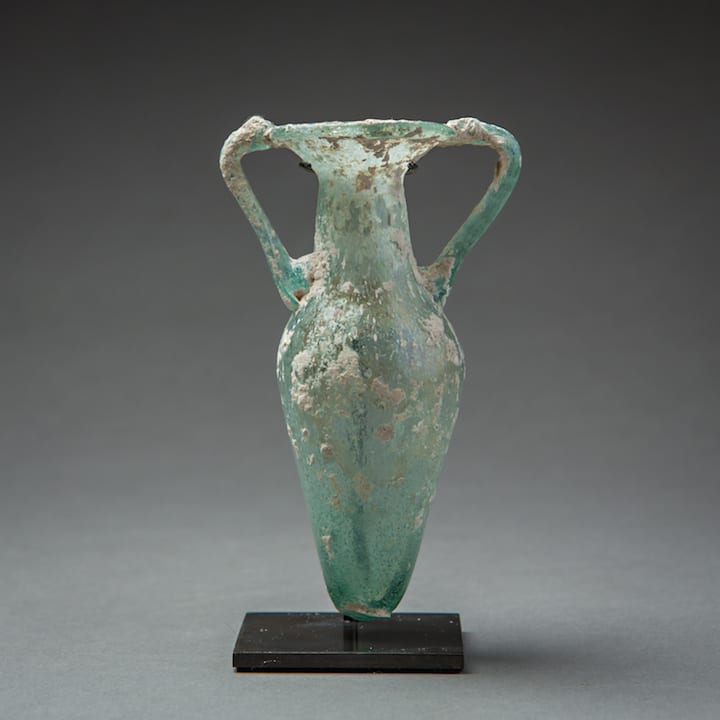Roman turquoise green glass Amphora shaped vessel, 3rd Century CE - 4th Century CE
Glass
height 10.9 cm
height 4 1/4 in
height 4 1/4 in
BB.1621
Extremely light and delicate amphora shaped vessel with slightly rounded conical body, pointed drop-shaped base, convex shoulder, short neck and flaring folded rim. Two handles applied from shoulder to below...
Extremely light and delicate amphora shaped vessel with slightly rounded conical body, pointed drop-shaped base, convex shoulder, short neck and flaring folded rim. Two handles applied from shoulder to below the rim.
Containers of this type, which reproduce the same shape as larger terracotta amphorae used throughout antiquity to store and transport liquids (especially wine), belong to a well-known class of miniature amphorae of similar hue with the same decorative technique. Very popular in the 3rd and 4th century A.D. throughout the Roman Empire – several have been found in the Near East (Syria and Egypt) as well as in Western Europe – this particular piece comes from Jerusale Used in different forms since the 2nd millennium B.C., glass definitely replaced clay as the raw material of choice for the manufacture of containers in all areas of daily life towards the end of the Hellenistic period. This event, which occurred gradually, is to be considered a major technological revolution of antiquity.
With a versatility like no other known material in Roman times, abundant availability and lightness and ease of use, glass enabled the imitation of a wide range of other materials (especially precious metals), whether in the form, the design or the color. Furthermore - and the ancients had certainly noticed this fact - glass is a chemically neutral substance, what makes it particularly suitable for the storage of food, but also of cosmetics or pharmaceutical products.
Containers of this type, which reproduce the same shape as larger terracotta amphorae used throughout antiquity to store and transport liquids (especially wine), belong to a well-known class of miniature amphorae of similar hue with the same decorative technique. Very popular in the 3rd and 4th century A.D. throughout the Roman Empire – several have been found in the Near East (Syria and Egypt) as well as in Western Europe – this particular piece comes from Jerusale Used in different forms since the 2nd millennium B.C., glass definitely replaced clay as the raw material of choice for the manufacture of containers in all areas of daily life towards the end of the Hellenistic period. This event, which occurred gradually, is to be considered a major technological revolution of antiquity.
With a versatility like no other known material in Roman times, abundant availability and lightness and ease of use, glass enabled the imitation of a wide range of other materials (especially precious metals), whether in the form, the design or the color. Furthermore - and the ancients had certainly noticed this fact - glass is a chemically neutral substance, what makes it particularly suitable for the storage of food, but also of cosmetics or pharmaceutical products.
